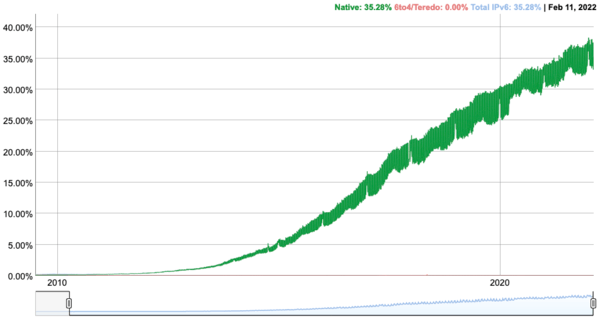What is IPv6?
Internet Protocol version 6 is the successor of version 4, which is still the most common protocol used to connect to the internet. The protocols are best known by their abbreviations IPv6 and IPv4. But what is IPv6? We will explain it to you.
Nowadays, all computers and so-called smart-devices are connected to the internet. Devices like your laptop, your smartphone and your tablet are able to communicate by assigning an address. The amount of devices being able to connect is even increased by also allowing smart-devices to connect. Examples of these are Smart-TVs, refrigerators, thermostats and cars. As a consequence of this big increase of connected devices, the amount of available IPv4 addresses is quickly running out, as there is a limited amount available. This is where IPv6 comes to the rescue.
This is where IPv6 comes in. It uses 128-bit addresses and are structured to contain 8 blocks, with each a maximum of 4 values that can contain either numbers or letters. For instance: 2a01:7c8:bb05:499:5054:ff:fec9:1f50.
IPv6 has been developed to overcome the limitations and shortcomings of IPv4. With the exponential growth of internet, and all parts of the world coming online, the limitation in available addresses will eventually cause huge problems. When taking into account the limitations of the IPv4 structure, it can hold a maximum of 4 billion unique addresses, which seems like a lot, but taking into account the amount of people that populate our world, it isn't enough to give out 1 address per person, let alone each device the average person has these days.
IPv6 however, has a limitation of 340,282,366,920,938,463,463,374,607,431,768,211,456 addresses, which is 340 trillion trillion trillion addresses. It is basically inexhaustible in the foreseeable future.
Because of the current limitations, another aspect is also noticeable. Web hosting providers, who earlier gave out unique IP-addresses to their customers are switching to shared IPv4 addresses, or are moving towards IPv6 to still be able to do this. With most providers, you will not be able to get your own IP, unless you rent your own server. Additionally, you will be required to pay extra to rent more. If you look back in time, it was not uncommon that every server included 10 unique IPv4 addresses. Nowadays, this is unheard off because of its scarcity. It is even becoming a target for investors.

The adoption rate of IPv6 throughout the years. Source: Google
IPv6 vs IPv4
One of the most important improvements to have been included in IPv6 vs IPv4 is that the IPsec security layer is mandated, unlike with its predecessor. This end-to-end protocol combines a series of security-measures which makes, for instance, something like Network Address Translation, also known as NAT or NATting, obsolete. Other features that are included by default are Quality of Service, also known as QoS, and multicasting. Although these were also possible with its predecessor, they were optional.The way the protocol functions isn't very different from its previous version. One of the most essential changes is the fact it doesn't use a network and broadcast-address anymore: The first address in its subnet is the designated router-anycast-address, which would be the network address in IPv4, while broadcast is no longer used and replaced by multicast including an all-IPv6 devices well-known multicast address and a solicited-node multicast address.
IPv6 compatibility
Most (new) devices, suitable for use with the internet, are compatible with the use of IPv6. However, there are exceptions. The main factor to keep in mind to judge if your devices could work is its operating system. For instance, if you are using Windows 10 or Windows 11, then it's definitely compatible, as are almost all Windows versions.If you look at another popular OS, Android, there is compatibility starting at version 5.0, also known as Lollipop. Their largest competitor, Apple, has rolled out a large update back in 2020 and 2021 to upgrade its operating system iOS and making their devices such as iPhone, iPad and MacBook compatible.
Devices still running on older, more obscure operating systems, which in general tend to not being upgrade anymore, usually lack compatibility. As a rule of thumb, everything released before 2014. You often have no other choice than writing it off and buying something new.
Compatible Operating Systems
Most of the operating systems in use are compatible with IPv6, but here is a list:- Windows 11
- Windows 10
- Windows 8
- Windows 7
- Windows Vista
- Windows XP (Service Pack 1 and up)
- Apple OS X (OS 10.7 and up)
- Android (Version 5.0 - Lollipop and up)
- iPhone / iPad iOS – updates 2020/2021
